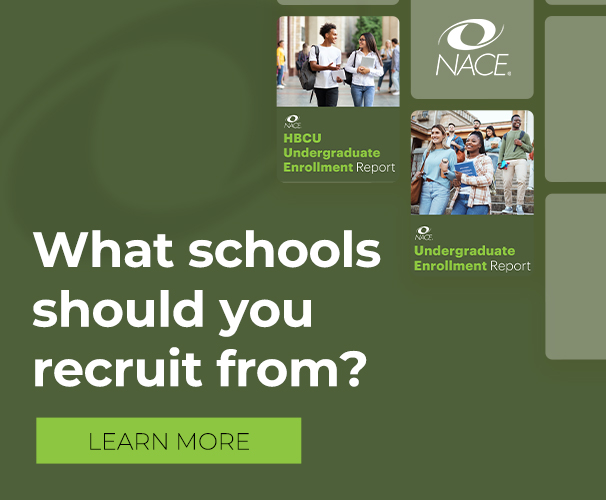NACE Journal, August 2021
During the 2019-2020 academic year, more than 1 million international students were enrolled in U.S. institutions, according to data from the Open Doors Report published by the International Institute of Education.1 Since the 1970s, the presence of international students across U.S. colleges and universities has been notable.2 The contributions of international students to their institutions are significant, ranging from research assistants to campus employees to student organization leaders. As administrators and staff, it is critical that we foster an environment of inclusion and belonging for this group, which starts with showing we value all they bring to our campuses.
International students are often sent from office to office, which builds frustration.
Inclusion and belonging are often very much absent during this experience.While all students experience challenges when transitioning to college and graduate school, research shows that the adjustment is even more difficult for international students.3 This includes emotional and social aspects, with the concept of culture shock at the forefront. This idea, conceptualized by Kalervo Oberg, is defined as anxiety experienced when entering a new culture and losing “accustomed cultural cues and social rules.”4 Other research notes that international students experience significant “cognitive fatigue” when transitioning to their U.S. institution, as processing of information often takes longer, and this may result in feelings of inferiority and self-doubt.5 Real mental exhaustion comes from managing a new culture. In addition, the sheer number of extra tasks international students are presented with upon arriving to their college or university adds challenges to adjustment. On top of general orientations and registrations, these students must complete extra paperwork, acquire new legal documents, attend additional orientations, and face added complications when it comes to working, both on and off campus, because of their visa status. They are often sent from office to office when navigating all these components, which builds frustration and may bring about negative feelings toward their institution’s administration.6 Inclusion and belonging are often very much absent during this experience.
As career development professionals, we have the opportunity to foster inclusion and belonging for international students by making it clear that their career development matters.
One of the best ways we can do this is by building a strong partnership between the career center and international student services. These two offices have a shared mission—both have a significant focus on supporting the employment of international students, specifically when it comes to entering the U.S. workforce. International student services staff put much of their time and resources into educating students about work authorization options and processing occupational practical training (OPT) and curricular practical training (CPT). Career center staff support international students to position themselves for employment and secure internships and jobs. There is a great deal of overlap in student advising across the two offices, as well as common themes within programming. When an international student services office and career center are closely connected, it eases the process of navigating the institution for international students and also has the potential to positively influence one’s sense of belonging within the university community.7
How do we build this relationship? Cross-training, networking, and collaboration are at the core.
Adviser Cross-training
While career coaches are not immigration experts, we should all have a solid understanding of work authorization options and processes, specifically for F-1 students who represent the majority of international students visiting our centers. Career development professionals should be prepared to talk to international students about when and how to bring up their visa status in the job search. We should also be able to advise students about how to educate employers about OPT and CPT, for example. While there is a gray area when it comes to work authorization, we should be able to confidently speak to the basic process of applying for OPT and CPT and be prepared to share virtual resources and programs around this during coaching appointments.
On the flip side, advisers within international student services should have a strong knowledge of career center resources and refer students not just to the career center, but also have the knowledge themselves to share virtual career resources and speak to general offerings.
Cross-office adviser training should be part of the employee onboarding process and occur annually for all staff, especially for those who focus on student advising. Ultimately, this training helps lessen the stress and frustration around navigating the institution and also communicates a united commitment to the career success of international students.
Cross-Office Networking
Another piece of developing this partnership is facilitating networking opportunities among staff members in the two offices.
During January 2020, New York University hosted a meet-and-greet program for 60+ staff from the Wasserman Center for Career Development and the Office of Global Services (OGS), with the underlying goal of building connections among staff as part of a larger effort to more holistically serve students in a high-quality and efficient manner.
The program began with structured networking through a “staff bingo” activity. This was followed by working through common, overlapping advising scenarios in small groups comprised of staff from both offices. These conversations allowed for sharing of best practices and valuable resources to support international students. Then, large group discussion around the scenarios occurred, resulting in some commitments to action from leadership in both departments. We also established Wasserman liaisons across teams to serve as point people to reach out to with questions related to international students following the session.
Hosting events like this also helps increase personalized referrals, which go a long way in helping students feel supported. When staff have individual connections to colleagues, they can call up that individual during an appointment or connect the student with that specific adviser via email. This limits the office hopping that contributes to mental fatigue and can also help students build trust and confidence in their institution.
Collaborative Events
Research emphasizes the importance of being proactive in offering programming specific to the career development needs of international students.8 Seeing such events on the semester calendar is part of what provides a foundation for inclusion and belonging.
Events that are co-sponsored and co-facilitated by the career center and international student services are very effective here; this partnership shows international students that their career development is valued by their institution. Examples of collaborative events include workshops co-presented by staff in both offices on such topics as “Job Searching for International Students,” “Navigating U.S. Work Culture,” and “International Identities in the Workplace.” Another great option is an international student career conference planned by a committee with representatives from both offices. Such an event could involve immigration attorneys, international alumni, and employers hiring F-1 and J-1 students, and presentations from both career center and international student services staff.
Another means of fostering belonging is including international student and alumni voices on panels and in events that feature guest speakers. When there is a strong relationship between the career center and international student services, connections across offices can be leveraged to identify individuals to participate.
Collaborate to Invest in Platforms Focused on International Students
Having specialized resources and platforms available for students to access is another way to foster inclusion and belonging for this population. Given that such resources are valuable to the mission of both the career center and international student services, cost-sharing across the two offices could be explored as a way to overcome financial barriers that may prevent the career center from subscribing on its own. The resources could be featured in both the career management system and international student services resources.
Additional Considerations
There are two additional factors that warrant consideration: physical location and the cultural competence of the professionals working with international students.
Research emphasizes the important role that physical location plays in an international student’s experience navigating their institution.9, 10 Arguments are presented for career centers and international student services to be located within the same building, or at least in proximity. This visible commitment to providing holistic support for international students has the potential to lessen barriers to engagement. It also communicates that the institution sees support of international students as a priority, which is critical to building trust.
In addition, we cannot talk about supporting international students without discussing the cultural competence of those who work with them: Culturally competent professionals are defined as those who work to build awareness around their own biases, seek to understand the worldview of their culturally diverse clients, and implement “culturally appropriate intervention strategies.”11 As career development professionals, it is important that we critically examine our assumptions, beliefs, attitudes, and limitations. When working with international students in a career context, a foundational part of this is valuing and respecting difference in professionalism across cultures, for instance. At the same time, we must take the initiative to learn about the culturally diverse groups we work with at our centers. For international students, this means learning about the range of cultures they represent; we can start by showing genuine interest during coaching appointments. We must engage in building cultural competence on an ongoing basis to support our international students. We must honor the experiences of these students by creating space for their stories.
When the career center and international student services build a strong partnership and ground initiatives in cultural competence, we position ourselves to provide holistic support for international students. This approach helps communicate that we value this group of students, and it holds the potential to positively influence the transition to the new institution and foster a sense of connection and belonging throughout their experience at our schools.
Endnotes
1 Institute of International Education. (2021). Using data to open doors. Retrieved from https://opendoorsdata.org/.
2 Hoekje, B. J., & Stevens, S. G. (2017). Creating a culturally inclusive campus : A guide to supporting international students. Routledge: New York.
3 Kaczmarek, P. G., Matlock, G., Merta, R., Ames, M. H., & Ross, M. (1994). An assessment of international college student adjustment. International Journal for the Advancement of Counselling,17(4), 241–247. https://doi.org/10.1007/BF01407740.
4 Winkelman, M. (1994). Cultural shock and adaptation. Journal of Counseling & Development,73(2), 121. https://doi.org/10.1002/j.1556-6676.1994.tb01723.x.
5 Mori, S. (2000). Addressing the mental health concerns of international students. Journal of Counseling & Development, 78(2), 139. https://doi.org/10.1002/j.1556-6676.2000.tb02571.x.
6 Hoekje, B. J., & Stevens, S. G. (2017).
7 Crockett, S., & Hays, D. (2011). Understanding and responding to the career counseling needs of international students. Journal of College Counseling, 14(1), 65-79. https://doi.org/10.1002/j.2161-1882.2011.tb00064.x.
8 Crockett, S., & Hays, D. (2011).
9 Crockett, S., & Hays, D. (2011).
10 Mori, S. (2000).137-144.
11 Sue, D. W., Sue, D., Neville, H. A., & Smith, L. (2019). Counseling the culturally diverse: Theory and practice. Wiley: New York, 139.
References/Resources
Oberg, K. (1960). Cultural shock: Adjustment to new cultural environments. Practical Anthropology, os-7(4), 177-182. https://doi.org/10.1177/009182966000700405.
Olivas, M., & Li, C. (2006). Understanding stressors of international students in higher education: What college counselors and personnel need to know. Journal of Instructional Psychology, 33(3), 217-222.






